#200 films of 1952 half way
Explore tagged Tumblr posts
Text

100 Films of 1952
Film number 100!! Lovely to Look At
Release date: May 29th, 1952
Studio: MGM
Genre: Musical
Director: Mervyn LeRoy
Producer: Jack Cummings
Actors: Kathryn Grayson, Red Skelton, Howard Keel, Ann Miller
Plot Summary: Al, Tony, and Jerry are three buddies struggling to find financial backers for their Broadway show. When Al discovers his recently deceased aunt has left him a dress shop in Paris, he thinks his money woes are over. In Paris, he meets his cousins Stephanie and Clarisse, who tell him the shop is nearly bankrupt. Is there any way to save both the shop and the show?
My Rating (out of five stars): ***
I would describe this as a pleasant confection- far from perfect or substantive, but not a bad way to spend 100 minutes. It’s lovely to look at while it lasts (see what I did there?), but afterward much of it will probably fade from memory.
The Good:
Marge and Gower Champion. Oh my god, I fell in love with these two! They are so adorable, they have lovely chemistry, and they dance beautifully. I wish they were the stars of the film- I smiled whenever they were on screen.
The big fashion show at the end. All hail Vincente Minnelli! He directed the final 15 minutes of the film, and it was stunning. The cinematography and design were ten times more interesting than what came before.
Ann Miller. Ann Miller’s legs. She’s ga-ga- gorgeous. I love the old 1940s/50s Hollywood body ideal. The women are allowed to have curves and some fleshiness. Ann Miller actually has thighs, and it’s glorious.
The music. Jerome Kern wrote the music for the original play and film Roberta, which this is a loose adaptation of. Songs like “I Won’t Dance,” “Smoke Gets in Your Eyes,” and “Lovely to Look At” are all very good.
There were a lot of songs in this- comedy numbers, ballads, dances and jazzier numbers... I always like musicals with a lot of music, and this fit the bill.
The Technicolor. Of course, of course, I have to mention the Technicolor! I always love it, and MGM was especially skilled at utilizing it.
The overall MGM quality. Even though this isn’t a great film, it has the incomparable look of an MGM movie. Here we are given all the advantages of the immense talent of MGM’s different departments- wardrobe, art direction, makeup, orchestra, etc. It looked and sounded beautiful.
Adrian gets a name drop. The famous fashion designer who worked at MGM was mentioned by Keel’s character as they sat at a French cafe.
A quote I loved- “Eat, drink, and be merry, for tomorrow is Thursday!”
The Bad:
Grayson and Keel were kinda boring. They were ostensibly the stars of the movie, but they weren’t very interesting. Both have pleasant voices, but their characters were pretty bland.
Why did they give Grayson that horrible, short, tightly curled 50s hair cut?! She looks so much nicer with long hair.
Red Skelton’s schtick gets old at times.
There was a running joke about a malfunctioning elevator that wasn’t funny the first, second, third, fourth, or fifth time.
Howard Keel’s character is delighted to keep making romantic moves on a woman who is so drunk she can barely stand up. She has to pass out on his shoulder for him to stop trying to kiss her. Yeah, gross.
The plot wasn’t exactly threadbare, but it was pretty loose at times. It might have been improved if it were tightened up a bit.
The musical numbers and comedy bits were very uneven- some were great, some were kind of boring, and some just didn’t work.
#project1952#1952 movies#100 films of 1952#200 films of 1952#200 films of 1952 film 100#200 films of 1952 half way
0 notes
Text
MARILYN MONROE
June 1, 1926 - August 4, 1962
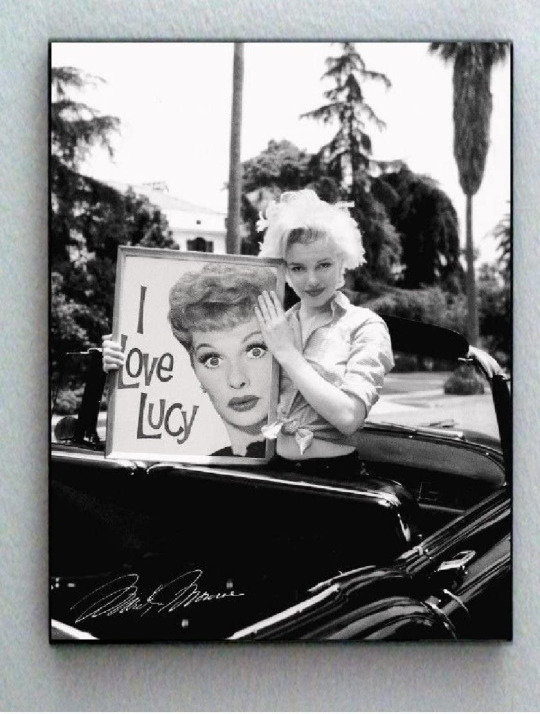
Marilyn Monroe (born Norma Jeane Mortenson) was an actress, model, and singer. Famous for playing comedic "blonde bombshell" characters, she became one of the most popular sex symbols of the 1950s and early 1960s and was emblematic of the era's changing attitudes towards sexuality. She was a top-billed actress for only a decade, but her films grossed $200 million by the time of her death in 1962. More than half a century later, she continues to be a major popular culture icon.
"When I was five I think, that's when I started wanting to be an actress. I didn't like the world around me because it was kind of grim, but I loved to play house. When I heard that this was acting, I said that's what I want to be. Some of my foster families used to send me to the movies to get me out of the house and there I'd sit all day and way into the night. Up in front, there with the screen so big, a little kid all alone, and I loved it.” ~ Marilyn Monroe,1962

Lucille Ball never worked with Marilyn Monroe, but meet her in 1953 at Ciro’s Nightclub on Sunset Strip, along with Betty Grable, and Red Skelton. Monroe’s immense popularity permeated Ball’s work none-the-less.
At the start of “Changing the Boys’ Wardrobe” (ILL S3;E10) the gang is heading to the movies to see “That picture we’ve been trying to get to for weeks with Marilyn Monroe.” The movie is likely Gentlemen Prefer Blondes, which premiered in New York City in July 1953. On November 5, 1953, the same day the episode was filmed, Monroe’s new film How to Marry a Millionaire was released in the US.
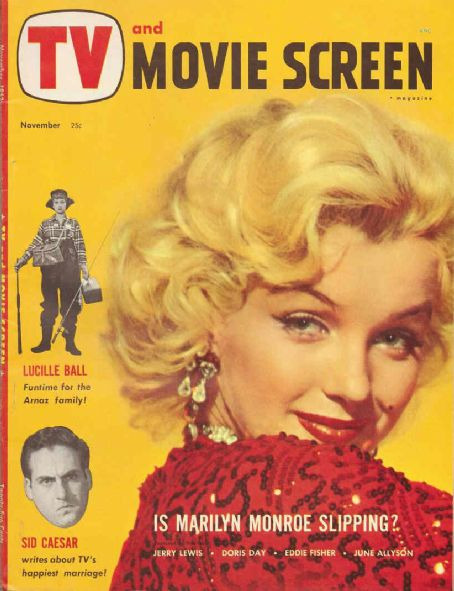
The November 1953 cover of TV and Movie Screen Magazine saw Lucy (in “The Camping Trip”) and Marilyn wearing the dress she wore on the May 1953 cover of Life Magazine promoting Gentlemen Prefer Blondes.
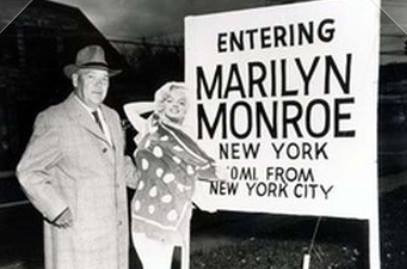
Also on November 5, 1953, the town of Monroe, New York (60 miles from New York City) was temporarily renamed Marilyn Monroe.

The film later inspired much of the plot of “Second Honeymoon” (S5;E14), Lucy’s failed attempt to make their transatlantic crossing to Europe more than just a working vacation.
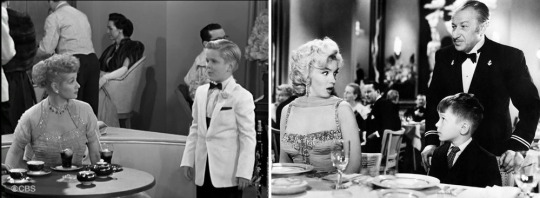
Monroe’s dinner companion turns out to be a seven year-old boy, just like Lucy’s ping pong partner turns out to be young Kenneth Hamilton (Harvey Grant).
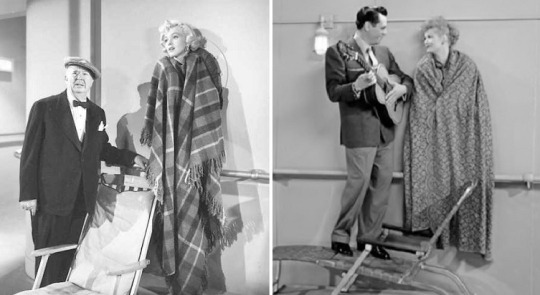
Lucy gets stuck in a porthole just as Monroe did, also draping a blanket around her shoulders so passersby wouldn’t know what was really going on.

The idea for the burlap potato sack dresses in ���Lucy Wants A Paris Gown” (ILL S5;E20) comes from Monroe’s real life.
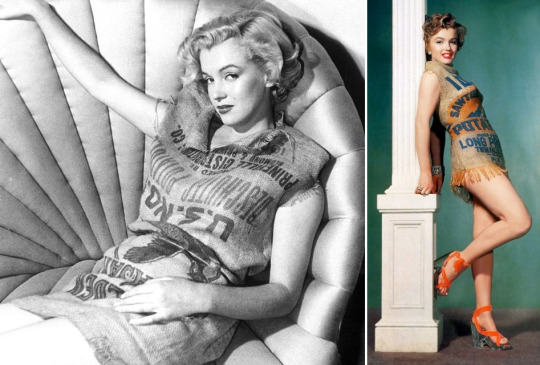
In 1951 Marilyn Monroe took a series of high fashion photographs wearing a potato sack as a response to a journalist who said that she might look sexier in a burlap sack than her usual fashion choices.
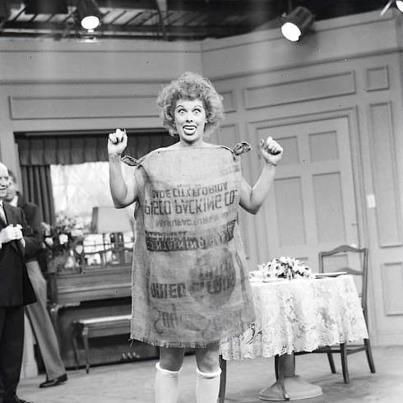
Lucy first wore burlap at the end of “Mr. and Mrs. TV Show” (ILL S4;E24) as her scary version of a Phipps make-over.

In “Ricky’s Movie Offer” (ILL S4;E5) Lucy and Ethel argue about who looks more like Marilyn Monroe.
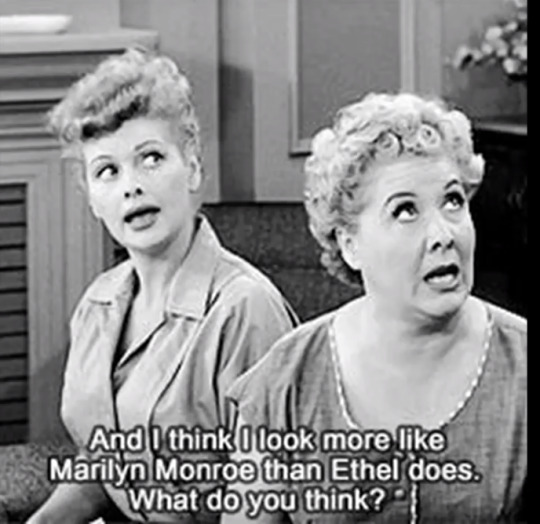
While Lucy has the facial features, Ethel has the blonde hair.

Fred (hilariously) settles the argument!
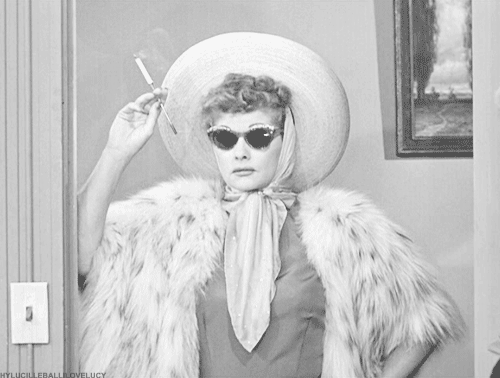
In “Ricky’s Screen Test” (ILL S4;E7) a long list of Hollywood names are dropped in anticipation of hobnobbing with celebrities, including Marilyn Monroe.
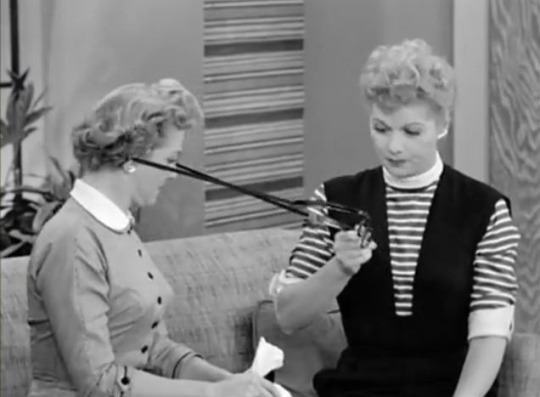
In “Lucy and Harpo Marx” (ILL S4;E28) Lucy wonders if Ethel might pass for Monroe to a near-sighted Carolyn Appleby. After Ethel tries to walk like Marilyn Monroe, Lucy decides that “nobody is that near-sighted!” Fred says that he looks more like Marilyn than either of them!
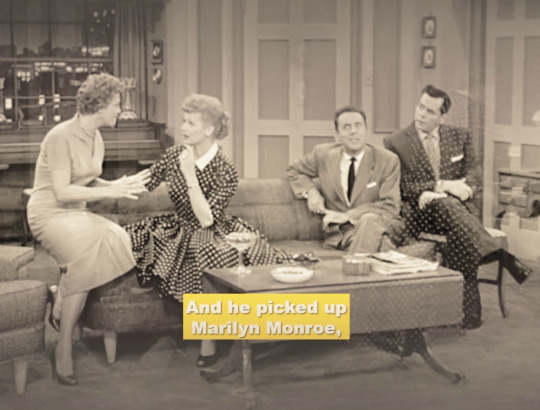
In “Lucy and Superman” (ILL S6;E13), the Appleby’s come over for a social evening that Ethel calls “the bore war” because the couples only talk about their children. As the scene opens, Caroline is in mid-sentence talking about a Marilyn Monroe film.
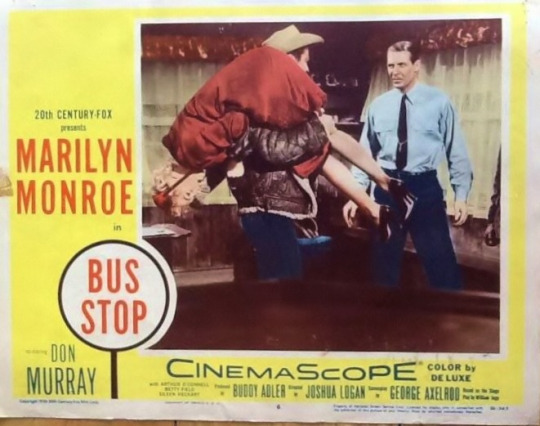
CAROLINE: “...and he picked up Marilyn Monroe, slung her over his shoulder and carried her off!”
Although the title is never mentioned, the film they are discussing is Bus Stop, starring Marilyn Monroe and Don Murray. It was released in August 1956, two and a half months before this episode was filmed.
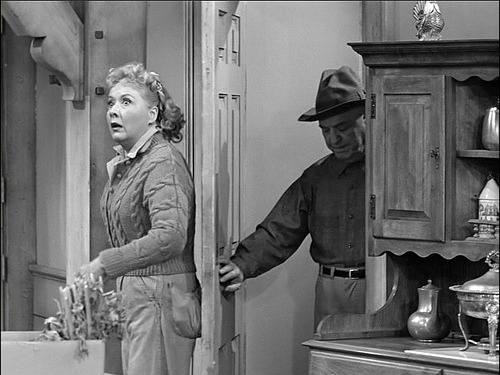
When “Lucy Does the Tango” (ILL S6;E20), she stuffs eggs down her blouse and Ethel stashes a some in her back pockets. Lucy tells her, “Whatever you do don’t try to walk like Marilyn Monroe,” but the ‘yolk’ is on Ethel when Fred suddenly enters through the kitchen door!
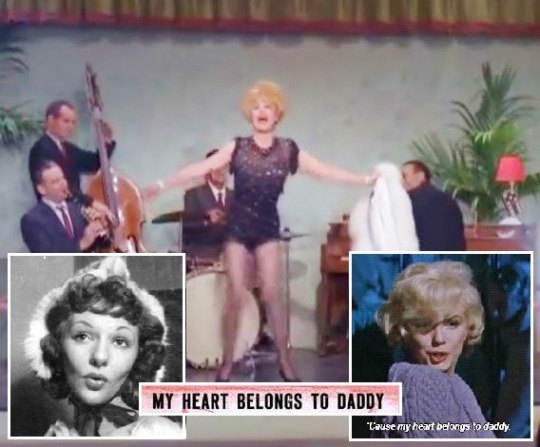
In “Lucy the Gun Moll” (TLS S4;E25), Lucy plays Lucy Carmichael and Rusty Martin. The name Rusty Martin was probably derived from Lucy’s hair color and the surname of Mary Martin, who introduced the song “My Heart Belongs to Daddy” (music and lyrics by Cole Porter) in the 1938 Broadway musical Leave It to Me. Marilyn Monroe sang it in the 1960 film Let’s Make Love. In that same film, Harry Cheshire, who played Sam Johnson in “Oil Wells” (ILL S3;E18), played Monroe’s father. Jerry Hausner (Jerry, Ricky’s Agent) and Joan Banks (Reporter Eleanor Harris in “Fan Magazine Interview”) played uncredited supporting roles.
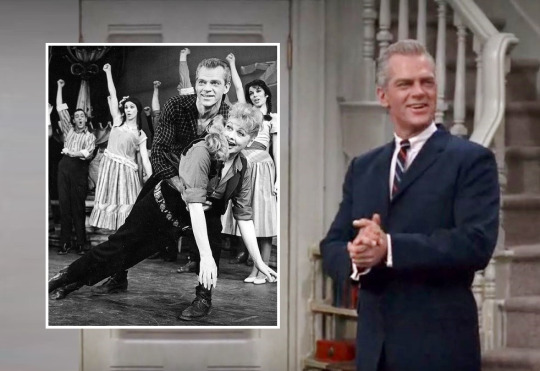
Lucy and Marilyn shared a leading man in handsome Keith Andes. Andes was Lucy’s male lead in Wildcat on Broadway, and later played was featured on three episodes of “The Lucy Show.”
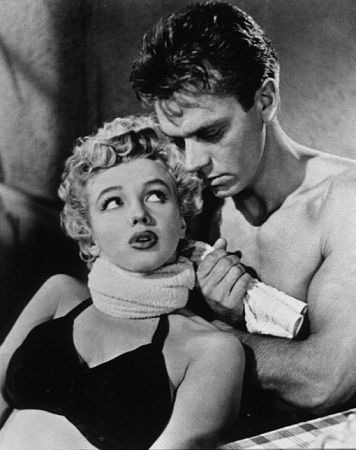
In 1952, he played opposite Marilyn in Clash By Night, an RKO picture.

In “Lucy Gets Ricky on the Radio” (1952), the June 3, 1952 of Look Magazine actually had Lucille Ball and Marilyn Monroe on the cover! Monroe was promoting Clash by Night, and Desi had written a feature on his wife for the magazine. So Marilyn actually did appear on “I Love Lucy” - if only in a still photo.
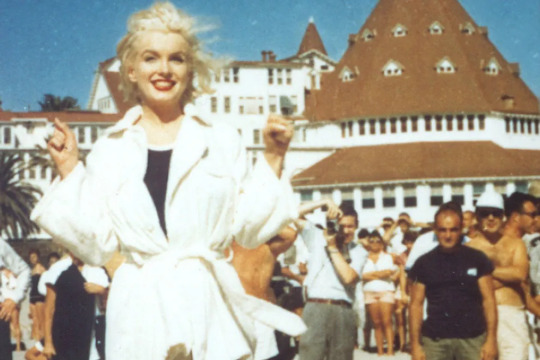

Some Like It Hot (1959) is arguably one of Marilyn Monroe’s most popular films. What does it have in common with Lucille Ball? In 1958, both Lucy and Monroe were depicted at San Diego’s famous Del Coronado Hotel. It is the hotel that the Ricardo’s and Mertzes stay at in “Lucy Goes to Mexico” (LDCH S2;E1) as well as the backdrop for much of the film. Although Desilu filmed establishing footage of the hotel, the cast stayed in Hollywood, while Monroe went on location (as seen above). In “Lucy Goes to a Hollywood Premiere” (TLS S4;E20), Mr. Mooney says he wouldn’t buy a second hand nightie if it had been worn by Jack Lemmon in Some Like It Hot.
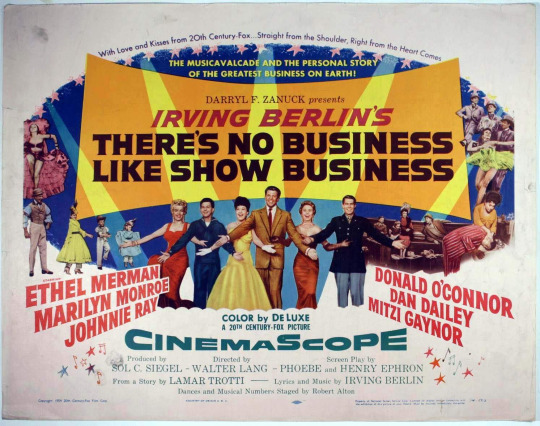
The Irving Berlin song “There’s No Business Like Show Business” was sung on “I Love Lucy” and “The Lucy Show.” Although it was originally from the Broadway musical Annie Get Your Gun (1946), it also served as the title and was performed (by Merman) in the Marilyn Monroe film There’s No Business Like Show Business in 1955.

In 1952, Marilyn co-starred by Richard Widmark (”The Tour” ILL S4;E30) in the film noir drama Don’t Bother To Knock. The film also featured “Lucy” players Lurene Tuttle (Fine Arts League President), Verna Felton (Mrs. Porter), Gloria Blondell (Grace Foster), as well as Harry Bartell, Olan Soule, Robert Foulke, and Bess Flowers.
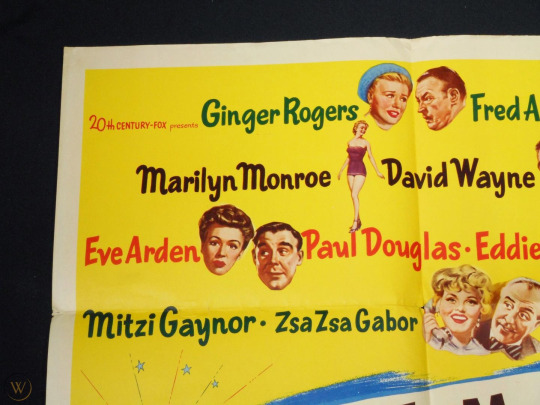
That same year, Monroe starred in We’re Not Married! opposite Lucy’s friend and former co-star Ginger Rogers, as well as Eve Arden (”Hollywood at Last!”), Paul Douglas (”Lucy Wants a Career”) and Eddie Bracken (Too Many Girls).
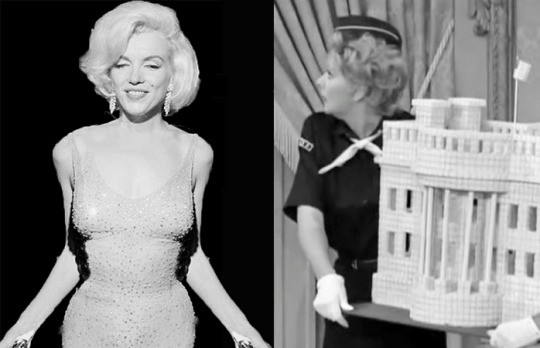
One of Monroe’s most iconic moments came in March 1962 when she sang “Happy Birthday” as a birthday present to President John F. Kennedy in a public birthday celebration also attended by Lucy’s friends and co-stars Jack Benny, Jimmy Durante, Henry Fonda, Danny Kaye, Shirley MacLaine and Elliott Reid. A year later, Lucy Carmichael also gave Kennedy a present, a sugar cube replica of the White House on “The Lucy Show” with Elliott Reid doing Kennedy’s offstage voice as well as playing a small on-camera role!
"I never quite understood it, this sex symbol. I always thought symbols were those things you clash together! That's the trouble, a sex symbol becomes a thing. I just hate to be a thing. But if I'm going to be a symbol of something I'd rather have it sex than some other things they've got symbols of." ~ Marilyn Monroe, 1962
Monroe was married (and divorced) three times:
James Dougherty, Merchant Marine & Policeman (1942-46)
Joe DiMaggio, Baseball Player (1954-55)
Arthur Miller, Playwright (1956-61)

In “Lucy is Enceinte” (ILL S2;E10), Fred gives Lucy a signed baseball for his future 'godson’. When he asks Lucy to read out the signature, she at first says “Spalding,” the ball’s brand name, but then finds it is signed by Joe DiMaggio.

In “Ragtime Band” (ILL S6;E21), Little Ricky asks his Uncle Fred:
LITTLE RICKY: “Who’s Joe 'Maggio?” FRED: “'Who’s Joe 'Maggio?’ You talk more like your father everyday.”
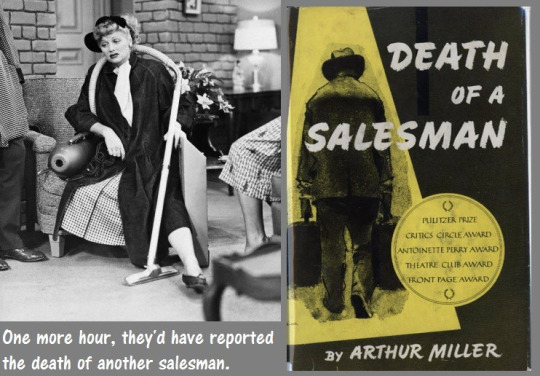
In “Sales Resistance” (ILL S2;E17), Lucy compares herself to Willy Loman, the title character in Death of a Salesman, a Pulitzer Prize-winning play by Arthur Miller first produced on Broadway in 1949 and made into an Oscar-nominated film in 1951.
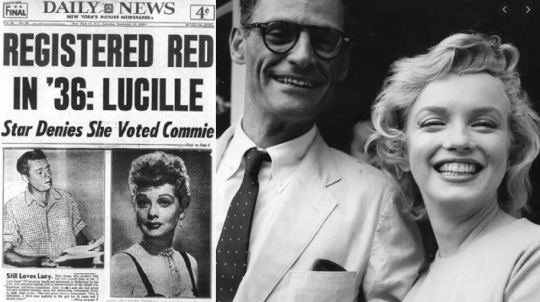
Speaking of husbands, Desi Arnaz has something in common with Marilyn Monroe, too. Both of their souses were accused of being Communists by the House Un-American Activities Committee during the 1950s. Both Lucille and Arthur Miller were cleared of charges and their careers continued, although that was not true for many celebrities of the time.
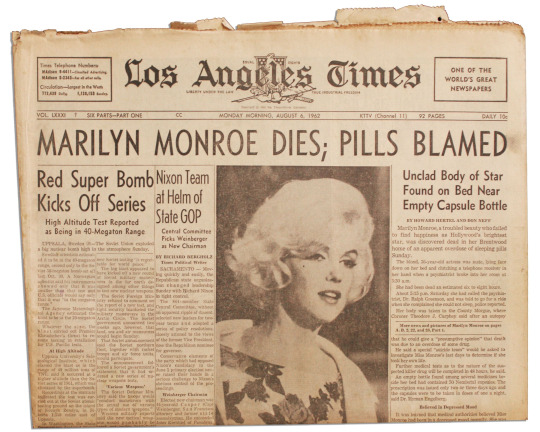
Monroe died on August 4, 1962. The toxicology report showed that the cause of death was acute barbiturate poisoning. Empty medicine bottles were found next to her bed. The possibility that Monroe had accidentally overdosed was ruled out because the dosages found in her body were several times over the lethal limit.
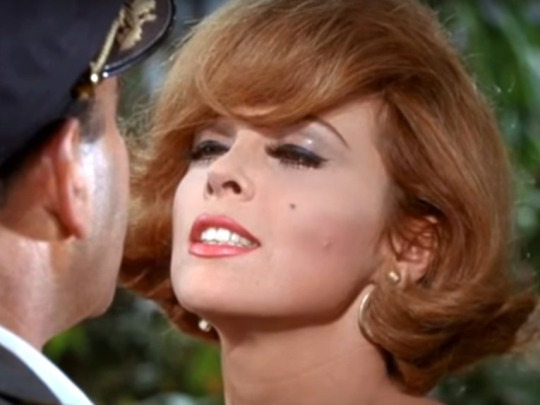
The character of Ginger, the movie star castaway on “Gilligan’s Island” (1964-67) was described during casting as a combination of Lucille Ball and Marilyn Monroe. Tina Louise had Lucy’s red (ginger) hair and Monroe’s shapely physique. The series also featured Natalie Schafer (Phoebe Emerson) as Mrs. Howell, and Alan Hale Jr. as the Skipper. Hale performed on “The Lucy Show” and “Here’s Lucy”. Series creator Sherwood Schwartz was a Lucy fan. His brother Elroy Schwartz actually wrote scripts for Lucille Ball.

In the 2013 web-series “Ryan & Ruby” both Lucille Ball and Marilyn Monroe are given special thanks for their inspiration. The last name of star and creator Ryan Burton's character is "Carmichael", the same as Ball's character on the "The Lucy Show". In Ryan’s kitchen there are fridge magnets with photos of both Lucy and Marilyn.
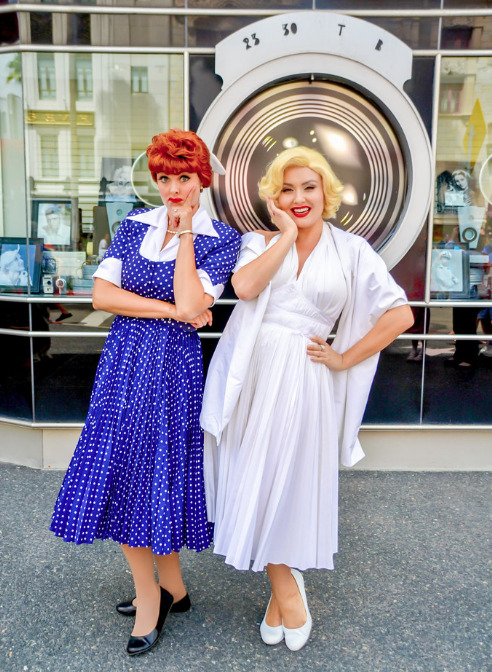
Lucy and Marilyn are street characters at Universal Studios theme parks, their iconic hair and costumes making them instantly recognizable.
The same day Marilyn Monroe was born in 1926, another Hollywood icon with connections to Lucille Ball was also born, Andy Griffith. To read his birthday blog, click here!
#Marilyn Monroe#Lucille Ball#I Love Lucy#William Frawley#Desi Arnaz#vivian vanc#the lucy show#Ryan and Ruby#Gilligan's Island#Tina Louise#Arthur Miller#Joe DiMaggio#Keith Thibodeaux#Alan Hale Jr.#natalie schafer#John F. Kennedy#Paul Douglas#Eve Arden#Ginger Rogers#Verna Felton#Ethel Merman#Richard Widmark#There's No Business Like Show Business#Hotel Del Coronado#Don't Bother To Knock#Some Like It Hot#Look Magazine#Keith Andes#Clash By Night#The Seven Year Itch
50 notes
·
View notes
Text
Some thoughts on movie musicals, since I’ve been watching a ton of them this year...
According to IMDB there were 200 MGM musicals. So far (in my life, not just this year) I have seen 63 of them. The oldest one I’ve seen is The Merry Widow (1934). The one I’ve watched most recently is Rosalie (1937). The best of them are obvious: Singin’ in the Rain (1952), The Wizard of Oz (1939), etc. The worst that I’ve seen so far are probably Hit the Deck (1955) and I Love Melvin (1953), although each definitely has elements to recommend it. My favorite new encounters of 2020 include The New Moon (1930), Rose Marie (1936), Give A Girl A Break (1953) and The Affairs of Dobie Gillis (1953) – the former two actually great movies, the latter two delightful fluff.
This year I’ve also watched at least a dozen musicals from RKO (including all the Rogers/Astaire films, every one a winner), another dozen from 20th Century Fox (with a focus on Alice Faye and Carmen Miranda, although Stormy Weather (1943) is probably better than all the Faye & Miranda films put together), and a handful each from Warner Bros and Disney, and one or two each from Columbia, Paramount and Universal. Love Me Tonight (1932, d. Mamoulian, Paramount) is my favorite of all the films I’ve watched for the first time this year. Some other delightful surprises were Strike Me Pink (1936), A Damsel in Distress (1937), and Cover Girl (1944), the first two because they were genuinely, hysterically funny. (Pink was an Eddie Cantor vehicle with Ethel Merman; Damsel a Fred Astaire picture with Burns & Allen. Cover Girl is the first film Gene Kelly choroegraphed and is considered by many the movie where we first saw him at his full power.)
Watching so many of these films so close together, with a heightened awareness of directors, choreographers, stars, and studio, has really given me a new perspective on the era (or really, the two eras, as there was a decisive break in musical filmmaking between the 30s and the mid-40s). You start to recognize locations (like that one mansion on the Fox lot that shows up in a half-dozen of their musicals) and costumes (eg. the “Broadway Melody” costumes from Singin’ in the Rain show up in the “It” number in Deep in My Heart) and songs (for example, “You Are My Lucky Star” shows up in a ton of MGM movies) and even plots (uppity college girl deigns to be wooed by the quarterback; French princess goes undercover as a mail order bride; and of course, students must put on a show to save their school).
And the repetition isn’t a bad thing -- what makes the films sparkle is the how, not the what. Every operetta might have its marching song, but listen to “Tramp, Tramp, Tramp” and “Stouthearted Men” and “The Riff Song” and “Song of the Vagabonds” back to back – rather than being bored by variations on a theme, you will be thrilled with the ways different talents attacked the same puzzle.
There’s also the bizarre situation where so many of these films were adapted from stage musicals but either the book or the score was entirely replaced -- so you get the story of Something For the Boys but only one Cole Porter song (and the replacement score is in no way comparable to what was discarded), or you get (more or less) the score of Girl Crazy with an entirely new story. With Rosalie, they took a show with a score by The Gershwins, Romburg and Wodehouse, threw out all the songs and hired Cole Porter to write a new one!
I said this earlier on Twitter, but it’s also fascinating to me, as someone who grew up on post-Rodgers & Hammerstein stage musicals (and their film adaptations) how little concern the filmmakers showed for form and structure. There were certain things that happened in most of the films, like an introductory number that establishes the film as a musical and often a wedding or other kind of coming together at the end, but beyond that? It’s the wild west, with no strict rules about song placement or function, who gets to sing or doesn’t, etc. And that in its own way is thrilling (if at times frustrating), because you never know what’s going to happen. (Although it also means some of the films can be meandering because there’s less of a clear direction of where the story is heading, if there’s even a story.)
Anyway, as long as we are staying home seven days a week I’ll probably continue this exploration. I doubt I’ll ever see all 200 of the MGM musicals (and I’m not sure that some of the early ones haven’t been lost), but deepening my engagement with and knowledge of this specific corner of my interests has been a fun side effect of all this time at home.
12 notes
·
View notes
Text
2017 Movie Odyssey
So ends the 2017 Movie Odyssey. Last year, I wrote that I did not foresee ever surpassing the 200+ movie mark for a long, long time. But look what happened here (outside of May because that was a hectic time in the Master’s program for sure). The 2017 Movie Odyssey consisted of 232 films - 180 feature-length films and fifty-two shorts. A century of filmmaking was covered this year, from 1917 to 2017. If I do have one regret this year... it’s that African films were not featured this year (due to availability issues and me not having enough money; I tend to watch things legally if possible). I hope to assuage that next year for a more representative Movie Odyssey.
For all of you out there who supported the Movie Odyssey in your own ways – whether reading, liking, commenting, or reblogging a write-up or sitting down with me to a new movie or talking to me about any movie... my thanks to all of you. None of this possible without you, and I hope you find that, through this blog, classic movies seem more approachable and welcoming and you are inspired to see some and learn about them yourself. A Happy New Year to all, and I’ll see you for the 2018 leg of the Movie Odyssey very soon (oh boy the Winter Olympics and World Cup are gonna chip away at the final count next year)!
As many know, all ratings are based on my imdb rating and half-points are always rounded down. My interpretation of that ratings system can be found here. A 6/10 is considered the borderline between “passing” and “failing”. Feature-length narrative films, short films, and documentaries are rated within their respective spectrums.
JANUARY
1. Marnie (1964) – 6/10 2. The Moon Is Down (1943) – 7/10 3. Sense and Sensibility (1995) – 8.5/10 4. The Big House (1930) – 7.5/10 5. Manchester by the Sea (2016) – 7/10 6. The Far Country (1954) – 7/10 7. Kung Fu Hustle (2004, Hong Kong/China) – 7/10 8. Road to Singapore (1940) – 6/10 9. A Clever Dummy (1917 short) – 5/10 10. Hidden Figures (2016) – 7.5/10 11. Teddy at the Throttle (1917 short) – 7.5/10 12. The Last of the Mohicans (1920) – 7/10 13. Sweet Smell of Success (1957) – 10/10 14. The Red Turtle (2016, France/Belgium/Japan) – 9/10 15. Life, Animated (2016) – 7.5/10 16. In the Mood for Love (2000, Hong Kong) – 10/10
FEBRUARY
17. Lion (2016) – 7/10 18. It’s Always Fair Weather (1955) – 7.5/10 19. Fences (2016) – 8.5/10 20. Shenandoah (1965) – 7/10 21. Caged (1950) – 8/10 22. Pearl (2016 short) – 7.5/10 23. Blind Vaysha (2016 short) – 8/10 24. Asteria (2016 short) – 6/10 25. The Head Vanishes (2016 short) – 6/10 26. Once Upon a Line (2016 short) – 7/10 27. Pear Cider and Cigarettes (2016 short) – 8/10 28. Sing (2016 short, Hungary) – 7.5/10 29. Silent Nights (2016 short, Denmark) – 6/10 30. Timecode (2016 short, Spain) – 7/10 31. Ennemis intérieurs (2016 short, France) – 8.5/10 32. La femme et le TGV (2016 short, Switzerland) – 8/10 33. Joe’s Violin (2016 short) – 7/10 34. Extremis (2016 short) – 8/10 35. 4.1 Miles (2016 short, Greece) – 9/10 36. Nashville (1975) – 7.5/10 37. The Romance of Transportation in Canada (1952 short) – 7/10
MARCH
38. My Life as a Zucchini (2016, Switzerland) – 8/10 39. Lili (1953) – 7/10 40. The Man from U.N.C.L.E. (2015) – 6/10 41. Captain Blood (1935) – 9.5/10 42. Logan (2017) – 7/10 43. Friendly Persuasion (1956) – 9/10 44. Ducks and Drakes (1921) – 7/10 45. What Dreams May Come (1998) – 6/10 46. Bright Road (1953) – 6/10 47. Snow Gets in Your Eyes (1938 short) – 5/10 48. Jungle Cat (1959) – 6.5/10 49. The Salesman (2016, Iran) – 8.5/10 50. Good Scouts (1938 short) – 7.5/10 51. All in a Nutshell (1949 short) – 8/10 52. The Hound That Thought He Was a Raccoon (1960) – 7/10 53. Winter Storage (1949 short) – 7/10 54. Out of Scale (1951 short) – 8/10 55. The Incredible Journey (1963) – 7/10 56. Follow Me, Boys! (1966) – 7/10 57. Charlie, the Lonesome Cougar (1967) – 5.5/10 58. Belladonna of Sadness (1973, Japan) – 6/10 59. Ponyo (2008, Japan) – 7/10 60. My Cousin Rachel (1952) – 7.5/10 61. Road to Perdition (2002) – 9/10
APRIL
62. The X from Outer Space (1967, Japan) – 3/10 63. The Blue Gardenia (1953) – 6.5/10 64. Get Out (2017) – 7.5/10 65. Fantastic Planet (1973, France/Czechoslovakia) – 8/10 66. 5 Centimeters Per Second (2007, Japan) – 6/10 67. Your Name (2016, Japan) – 7.5/10 68. The Outlaw and His Wife (1918, Sweden) – 7/10 69. Mail Early (1941 short) – experimental film, score withheld 70. Boogie-Doodle (1948 short) – experimental film, score withheld 71. A Chairy Tale (1957 short) – 9/10 72. Very Nice, Very Nice (1961 short) – experimental film, score withheld 73. Fine Feathers (1968) – 7/10 74. What on Earth! (1967 short) – 8/10 75. Walking (1968 short) – 7/10 76. Notes on a Triangle (1966 short) – experimental film, score withheld 77. The Three Faces of Eve (1957) – 7.5/10 78. Peeping Tom (1960) – 7.5/10 79. Porco Rosso (1992, Japan) – 8/10 80. MacArthur (1977) – 6/10
MAY
81. Dr. Goldfoot and the Bikini Machine (1965) – 4/10 82. Scarlet Street (1945) – 8.5/10 83. Tremors (1990) – 7/10 84. The Crucified Lovers (1954, Japan) – 7.5/10 85. Akeelah and the Bee (2006) – 8/10
JUNE
86. Wonder Woman (2017) – 7/10 87. Pollyanna (1960) – 7.5/10 88. Mickey’s Polo Team (1936 short) – 8/10 89. Tales of Manhattan (1942) – 7/10 90. The Horse with the Flying Tale (1960) – 7/10 91. Sound of the Mountain (1954, Japan) – 9/10 92. Return of the Fly (1959) – 4/10 93. Friday the 13th (1980) – 4/10 94. The Tattooed Police Horse (1964) – 6/10 95. Dr. Jack (1922) – 7/10 96. Pat Garrett and Billy the Kid (1973) – 7/10 97. Friday the 13th Part 2 (1981) – 5/10 98. The Great Man (1956) – 8/10 99. Sparrows (1926) – 7.5/10 100. Seven Days to Noon (1950) – 9/10 101. My Neighbor Totoro (1988, Japan) – 8.5/10 102. The Pocket Man (2016 short, France) – 7/10 103. Snack Attack (2012 short) – 7/10 104. You Were Never Lovelier (1942) – 7/10 105. San Francisco (1936) – 7.5/10 106. Eraserhead (1977) – 6.5/10
JULY
107. The Beguiled (2017) – 7/10 108. Summer Magic (1963) – 6/10 109. The Southerner (1945) – 9/10 110. The Statue of Liberty (1985) – 6/10 111. They Live by Night (1948) – 8/10 112. A Little Romance (1979) – 6/10 113. Conflagration (1958, Japan) – 6.5/10 114. The Naughty Twenties (1951 short) – 5/10 115. The Fastest Gun Alive (1956) – 7/10 116. For Your Eyes Only (1981) – 6/10 117. A Man There Was (1917, Sweden) – 9.5/10 118. His Royal Slyness (1920 short) – 6/10 119. Now or Never (1921 short) – 6.5/10 120. Among Those Present (1921 short) – 6/10 121. Dawn of the Planet of the Apes (2014) – 7.5/10 122. Independence Day (1996) – 5/10 123. Yoyo (1965, France) – 8/10 124. The Man Who Knew Too Much (1934) - 6.5/10 125. War for the Planet of the Apes (2017) – 7.5/10 126. The Lady Vanishes (1938) – 10/10 127. Funny Face (1957) – 9/10 128. A Brighter Summer Day (1991, Taiwan) – 9.5/10 129. A Sailor-Made Man (1921) – 6/10 130. Much Ado About Nothing (1993) – 8/10 131. Dunkirk (2017) – 8.5/10 132. Lost Horizon (1937) – 8/10 133. The Man from Snowy River (1982) – 7.5/10 134. A Touch of Zen (1971, Taiwan) – 10/10
AUGUST
135. A Double Life (1947) – 6/10 136. Tokyo Chorus (1931, Japan) – 7/10 137. In a Heartbeat (2017 short) – 7.5/10 138. Valerian and the City of a Thousand Planets (2017) – 4.5/10 139. Twelve O’Clock High (1949) – 9/10 140. The Big Clock (1948) – 7/10 141. Pink Floyd – The Wall (1982) – 8/10 142. Record of a Tenement Gentleman (1947, Japan) – 9/10 143. Octopussy (1983) – 6/10 144. West of Zanzibar (1928) – 6/10 145. Take Me Out to the Ball Game (1949) – 7/10 146. Detroit (2017) – 5.5/10 147. That Funny Feeling (1965) – 6/10 148. Kid Galahad (1962) – 6/10 149. Tokyo Twilight (1957, Japan) – 10/10 150. In This Corner of the World (2016, Japan) – 7/10 151. The Bedford Incident (1965) – 7.5/10 152. Johnny Express (2014 short) – 6/10 153. Carpark (2013 short) – 6/10 154. Castle in the Sky (1986, Japan) – 8/10 155. The Goonies (1985) – 7.5/10 156. State of the Union (1948) – 6/10
SEPTEMBER
157. Beyond the Poseidon Adventure (1979) – 3/10 158. Muscle Beach Party (1964) – 4/10 159. The Nutty Professor (1963) – 7/10 160. Camille (1921) – 6.5/10 161. Aguirre, the Wrath of God (1972, West Germany) – 8/10 162. Independence Day: Resurgence (2016) – 2/10 163. It (2017) – 7/10 164. Ocean Waves (1993, Japan) – 6/10 165. Monterey Pop (1968) – 8/10 166. Don’t Look Back (1967) – 9/10 167. Tyrus (2015) – 8.5/10
OCTOBER
168. A Star Is Born (1937) – 8/10 169. Swiss Family Robinson (1960) – 6/10 170. Revenge of the Nerds (1984) – 5/10 171. Horton Hears a Who! (2008) – 6/10 172. Freaky Friday (1976) – 6/10 173. The Great Muppet Caper (1981) – 7.5/10 174. Mr. & Mrs. ’55 (1955, India) – 8/10 175. Island of Lost Souls (1932) – 9.5/10 176. The Little Broadcast (1943 short) – 6.5/10 177. Hoola Boola (1941 short) – 6/10 178. The Sleeping Beauty (1935 short) – 7/10 179. Tulips Shall Grow (1942 short) – 8.5/10 180. Charulata (1964, India) – 8/10 181. Together in the Weather (1946 short) – 6/10 182. John Henry and the Inky-Poo (1946 short) – 7.5/10 183. Philips Cavalcade (1934 short) – 7/10 184. Jasper in a Jam (1946 short) – 8/10 185. Tubby the Tuba (1947 short) – 9/10 186. The Puppetoon Movie (1987) – 7/10 187. Brides of Dracula (1960) – 7/10 188. Blackbeard’s Ghost (1968) – 7/10 189. Candleshoe (1977) – 6/10 190. Jigoku (1960, Japan) – 5.5/10 191. Blacula (1972) – 6/10 192. Willard (1971) – 4/10 193. Ben (1972) – 4.5/10
NOVEMBER
194. The Coward (1965, India) – 7/10 195. The Happening (2008) – 2/10 196. Tom Thumb (1958) – 6.5/10 197. Strike (1925, Soviet Union) – 7.5/10 198. Loving Vincent (2017) – 7/10 199. Destry Rides Again (1939) – 7.5/10 200. The Master Race (1944) – 6/10 201. Justice League (2017) – 6/10 202. Sissi (1955, Austria) – 7.5/10 203. Sissi: The Young Empress (1956, Austria) – 7/10 204. The Sandlot (1993) – 7/10 205. Olaf’s Frozen Adventure (2017 short) – 4/10 206. Coco (2017) – 8/10 207. Sissi – Fateful Years of an Empress (1957, Austria) – 7/10 208. The Florida Project (2017) – 8.5/10 209. The Mortal Storm (1940) – 7/10 210. The Breadwinner (2017) – 8/10 211. Spencer’s Mountain (1963) – 6/10 212. Lady Bird (2017) – 9/10
DECEMBER
213. The Four Horsemen of the Apocalypse (1921) – 8.5/10 214. The Secret Life of Bees (2008) – 7/10 215. Murder on the Orient Express (2017) – 5.5/10 216. So You Think You’re Allergic (1945 short) – 5/10 217. Three Billboards Outside Ebbing, Missouri (2017) – 7.5/10 218. The Shape of Water (2017) – 8.5/10 219. Lonely Are the Brave (1962) – 9.5/10 220. Star Wars: The Last Jedi (2017) – 7/10 221. They Won’t Forget (1937) – 8/10 222. It Came from Outer Space (1953) – 6.5/10 223. Brave Little Tailor (1938 short) – 8/10 224. The Story of Robin Hood and His Merrie Men (1952) – 6/10 225. The Sign of Zorro (1958) – 5/10 226. Kong: Skull Island (2017) – 6.5/10 227. Flipped (2010) – 6/10 228. Bardelys the Magnificent (1926) – 7.5/10 229. There’s No Business Like Show Business (1954) – 7/10 230. Swim Team (2016) – 7/10 231. Toby Tyler (1960) – 5/10 232. The Liberator (2013, Venezuela) – 6/10
All scores are subject to change (upgrades and downgrades) upon a rewatch.
3 notes
·
View notes
Text
The Disastrous Production of Howard Hughes’ 20,000 Leagues Under the Sea

Disney’s 1954 production of Jules Verne’s 20,000 Leagues by Richard Fleischer has long been the definitive cinematic version of the story. But it was not the first to enter production. In 1946, famous billionaire Howard Hughes attempted to make the film, following “The Outlaw” which would become his final completed film as director. The production would become one of Hollywood’s greatest disasters, taking the lives of over 90 actors and crew, costing nearly half a billion dollars (adjusted for inflation), destroying an entire island, and almost causing a third world war.
As the second world war drew to a close, Hughes was setting his sights on what he intended to be his magnum opus. Verne’s book had long been an inspiration to Hughes, in part inspiring his ventures into nautical enterprises, including the construction of the “Mahogany Mackerel,” one of the largest ships ever to sail. A party was held to mark the start of production at one of Hughes’ seaside homes outside of San Francisco (the mansion is now the home of director David Fincher), and was sadly marred when a drunken Hughes began shooting into the air with his crossbow and killed an albatross, which fell into the punch bowl.

The party featured the intended stars of the film, actors Gene Kelly, Gregory Peck, and Orson Welles who would portray Captain Nemo. It was an early blow to the film when all three actors departed the production on its first day due to infighting over an unsuccessful orgy the prior week. This caused a massive production delay during which Hughes bought up over 50 warehouses (including the world’s largest building at the time) to hold the sets and specially built water tanks until casting was replenished.
Two of these warehouses burned down (including the world’s largest building fire at the time), destroying the sets which then had to be rebuilt. By the time Hughes decided to cast unknown actors in the lead roles, ten more major set pieces had rotted away delaying the production further. Finally in October of 1948 the new sets and all actors were in place on the luxurious island of Bikini Atoll. The crew was to arrive at the shooting location on October 26th but was delayed by weather. This turned out to be a good thing as the United States conducted an unannounced nuclear test on October 27th, annihilating the island and the sets completely. The island is still not inhabitable to this day, and Howard Hughes, who owned the island, was compensated only $212 (adjusted for inflation) for his losses by the government.

Undeterred, Hughes began again with fresh sets, and new actors as the previous group had long since departed by 1950. This time, production finally began and footage was shot. It was never developed however because despite the expenditure of $800,000 (adjusted for inflation) on pyrotechnics for the first scenes shot, nobody had thought to temperature-protect the film canisters, which were opened at the lab and found to have melted completely into what amounted to large plastic hockey pucks. Hughes filmed the scene again, at the same cost, and then a third time when he was not satisfied with a background extra’s hair. This new footage too was lost when it was captured by rebellious 1950s teenagers who held it for ransom. They asked only $50 (adjusted for inflation) but Hughes refused to pay on principle.
The actors and crew were even more upset than Hughes that their work had been for nothing and so began the “Leagues Riots” of 1951. What sets remained were once more burned down, this time in protest. The lead actors were rehearsing in the sets at the time and all died of smoke inhalation. Hughes was also injured in an unrelated accident on the same day when he flew an experimental plane on its first test flight. He managed to steer the wayward jet back to his own property but missed the runway and instead crashed into another set, which had already been rigged for pyrotechnics the previous night, resulting in the loss of the set, pyro, plane, Hughes left pinky toe, and over 30 million dollars in production costs (adjusted for inflation).
Then the real problems began.
Hughes replaced the lead actor with Sam Normanjensen, once thought to be an great star on the rise. Unfortunately he was also a serial killer known then as the Sherman Oaks Ripper. He had killed 17 actors before he was cast, and filmed for only two weeks before he slaughtered and ate the spleen of one of his co-stars. Hughes was exonerated of any negligence but only after 50 million dollars (adjusted for inflation) in court fees and settlements with the actors family, one member of which visited the set on a later filming day to fire his pistol randomly at the remaining cast in anger, killing two more, wounding Hughes who lost his right testicle, and destroying a filming balloon that was the largest air vehicle ever built at the time (adjusted for inflation).

It was then that the Verne family withdrew their rights from the plagued production. Another legal battle cost in the millions, and by the time it was over in 1952, the sets had once again rotted away and had to be rebuilt. By that time, the Disney production was under way and Hughes spent millions more to spy on and sabotage the rival production. Several Disney employees fell victims to car bombs, others to arsenic poisoning, and one to auto-erotic asphyxiation, but Hughes was not considered responsible for that particular event. Walt Disney, of course, declared war.
The “War Between The Sets” began in 1953 as Hughes forces were driven off by Disney’s hired guns, the Mouseketeers which in those days were a fully armed paramilitary force. This skirmish took seven lives, but it was only the beginning. Hughes used his government contracts to secure two bombers and arms weighing in excess of 500 tons, all of which were dropped on Disney owned installations. Disney’s retaliation was severe. Hughes hotels burned days after, there were so many fires that Vegas and LA were both lit as bright as daylight even at midnight from the blazes. Hughes responded with bombings and drone strikes, with “drone strikes” in 1953 referring to dropping bees on ones enemy. One such strike which killed Disney’s allergic son, Walt Disney III (There was no Walt Disney II as Walt felt that talent skipped a generation). The conflict at one point threatened to spill over into Russia’s Southern American interests, leading the president to demand Hughes back down before turning the cold war into a nuclear conflict.

By the time a truce was called, Disney’s film was in theaters and Hughes was ready to call it a loss. He became reclusive and wasn’t seen much in public from that time on. Disney continued to be one of the largest entertainment companies in the world, and remains the producer of the most definitive adaptation of 20,000 Leagues Under The Sea.
The book has not been adapted since, but David Fincher’s new version begins filming next week on a budget over 200 million dollars. Sadly, the production has already seen its first fatality, when fireworks during the production party at Fincher’s San Francisco home went astray and killed an albatross.
We at FIJMU wish Fincher the best of luck on his upcoming production. He’s going to need it.
3K notes
·
View notes
Photo

https://youtu.be/nSR7YAdqurU
Ella Fitzgerald was the First African-American to Win Grammy Award in 1958. She won 14 Grammys. Here is her fascinating life story:
Born on April 25, 1917 in Newport News, Virginia, singer Ella Fitzgerald was the product of a common-law marriage between William Fitzgerald and Temperance "Tempie" Williams Fitzgerald. Ella experienced a troubled childhood that began with her parents separating shortly after her birth. With her mother, Fitzgerald moved to Yonkers, New York. They lived there with her mother's boyfriend, Joseph Da Silva. The family grew in 1923 with the arrival of Fitzgerald's half-sister Frances. Struggling financially, the young Fitzgerald helped her family out by working as a messenger "running numbers" and acting as a lookout for a brothel. Her first career aspiration was to become a dancer. After her mother's death in 1932, Fitzgerald ended up moving in with an aunt. She started skipping school. Fitzgerald was then sent to a special reform school but didn't stay there long. By 1934, Ella was trying to make it on her own and living on the streets. Still harboring dreams of becoming an entertainer, she entered an amateur contest at Harlem's Apollo Theater. She sang the Hoagy Carmichael tune "Judy" as well as "The Object of My Affection," wowing the audience. Fitzgerald went on to win the contest's $25 first place prize. That unexpected performance at the Apollo helped set Fitzgerald's career in motion. She soon met bandleader and drummer Chick Webb and eventually joined his group as a singer. Fitzgerald recorded "Love and Kisses" with Webb in 1935 and found herself playing regularly at one of Harlem's hottest clubs, the Savoy. Fitzgerald also put out her first No. 1 hit, 1938's "A-Tisket, A-Tasket," which she co-wrote. Later that year Ella recorded her second hit, "I Found My Yellow Basket." In addition to her work with Webb, Fitzgerald performed and recorded with the Benny Goodman Orchestra. She had her own side project, too, known as Ella Fitzgerald and Her Savoy Eight. Following Webb's death in 1939, Ella became the leader of the band, which was renamed Ella Fitzgerald and Her Famous Orchestra. (Some sources refer to the group as Ella Fitzgerald and Her Famous Band.) Around this time, Fitzgerald was briefly married to Ben Kornegay, a convicted drug dealer and hustler. They wed in 1941, but she soon had their union annulled. Going out on her own, Fitzgerald landed a deal with Decca Records. She recorded some hit songs with the Ink Spots and Louis Jordan in the early 1940s. Fitzgerald also made her film debut as Ruby in 1942's comedy western Ride 'Em Cowboy with Bud Abbott and Lou Costello. Her career really began to take off in 1946 when she started working with Norman Granz, the future founder of Verve Records. In the mid-1940s, Granz had started Jazz at the Philharmonic, a series of concerts and live records featuring most of the genre's great performers. Fitzgerald also hired Granz to become her manager. Around this time, Fitzgerald went on tour with Dizzy Gillespie and his band. She started changing her singing style, incorporating scat singing during her performances. Fitzgerald also fell in love with Gillespie's bass player Ray Brown. The pair wed in 1947, and they adopted a child born to Fitzgerald's half-sister whom they named Raymond "Ray" Brown Jr. The marriage ended in 1952. The 1950s and '60s proved to be a time of great critical and commercial success for Fitzgerald, and she earned the moniker "First Lady of Song" for her mainstream popularity and unparalleled vocal talents. Her unique ability to mimic instrumental sounds helped popularize the vocal improvisation of scatting, which became her signature technique. In 1956, Fitzgerald began recording for the newly created Verve. She made some of her most popular albums for the label, starting out with 1956's Ella Fitzgerald Sings the Cole Porter Song Book. At the very first Grammy Awards in 1958, Fitzgerald picked up her first two Grammys—and made history as the first African-American woman to win the award—for best individual jazz performance and best female vocal performance for the two songbook projects Ella Fitzgerald Sings the Duke Ellington Song Book and Ella Fitzgerald Sings the Irving Berlin Song Book, respectively. (She worked directly with Ellington on the former album.) A truly collaborative soul, Fitzgerald produced great recordings with such artists as Louis Armstrong and Count Basie. She also performed several times with Frank Sinatra over the years as well. In 1960, Fitzgerald broke into the pop charts with her rendition of "Mack the Knife." She was still going strong well into the '70s, playing concerts across the globe. One especially memorable concert series from this time was a two-week engagement in New York City in 1974 with Sinatra and Basie. By the 1980s, Fitzgerald experienced serious health problems. She had heart surgery in 1986 and had been suffering from diabetes. The disease left her blind, and she had both legs amputated in 1994. She made her last recording in 1989 and her last public performance in 1991 at New York's Carnegie Hall. Ella Fitzgerald died on June 15, 1996, at her home in Beverly Hills. In all, Fitzgerald recorded more than 200 albums and some 2,000 songs in her lifetime. Her total record sales exceeded 40 million. Her many accolades included 14 Grammy Awards, the NAACP Image Award for Lifetime Achievement and the Presidential Medal of Freedom. While some critics complained that her style and voice lacked the depth of some her more bluesy counterparts, her success and the respect she garnered from the biggest names in the music industry showed that Fitzgerald was in a class all her own. Mel Torme described her as "the High Priestess of Song" and Pearl Bailey called her "the greatest singer of them all," according to Fitzgerald's official website. And Bing Crosby once said, "Man, woman or child, Ella is the greatest of them all." Since her passing, Fitzgerald has been honored and remembered in many ways. The United States Postal Service honored the late singer with an Ella Fitzgerald commemorative stamp celebrating the 90th anniversary of her birth. That same year, the tribute album We All Love Ella: Celebrating the First Lady of Song featured such artists as Gladys Knight, Etta James and Queen Latifah performing some of Fitzgerald's classics. Sources: YouTube and biography.com
#ella fitzgerald#grammy winner#First Lady of Song#black history month#ride em cowboy#verve#mack the knife#louis armstrong#count basie
17 notes
·
View notes
Link
Ishwarbhai is a snake charmer: He used to cut snakes from jungles, bushes and other areas where snakes can be easily found. Then, he used to tame these snakes and then goes to town to town and show the snake charm and the game to people. People are very fond of snake charming games and they were giving some money after the game. That money was his livelihood for his family.
Ishwarbhai is a snake charmer and he was forced to adopt begging due to the advent of the Wildlife Protection Act. Wild Life Protection Act snapped the snake from him. Snakes were his medium of lively hood. As a result of this, he was forced to beg. He had no education. He was devoid of any specialized skills. He was forced to do begging. Otherwise he would have to die without food.
Now, there are two and half lakhs of snake charmer dwelling in Gujrat and they are resorting to begging in order to fulfil the want of their belly. They are the invisible people, who are unwanted from every class of society and they are resorting to some other acts in order to earn a livelihood. Some are going way to do acrobat with fire in the mouth and some are begging. What is sad that they are leaving behind their age old profession, which is passed through them from generations.
They are caught between law of the land. According to the Wild Life Protection Act prohibition of hunting. – No person shall hunt any wild animal specified in Schedule, I, II, III and IV except as provided under section 11 and section 12. The hunting of wild animals is permitted in certain cases. In reality, the entire process is such an elaboration that an illiterate person like Ishwarbhai is not going to pursue that route.
The killing of a wild animal is allowed in certain cases like that of education, scientific innovation and scientific research purposes. My father is a banker and during my childhood days, I was experiencing some of snake charmer games as well as monkey games. They were reaching to schools and would be taking permission from the principal and then they would be showing snake charmer games to pupils.
School principal would be giving some money to a snake charmer. Snake charmer’s passion for showing snakes was phenomenal and wonderful. He was using his intelligence to show the snakes to little kids as if he was showing some magic. The box from which the snakes were there giving some awful nightmares for us as small kids.
Now, that snake charmer game is not there. Current generations are understanding what is it in this, the sheer joy in seeing the snakes in the open and with it he was giving many advices of how to keep a safe distance from snakes and how to stay out of it. In this manner, the small kids in the past were learning the dangers of touching snakes. Now, the profession of snake charmer is almost over. If you are seeing this, then they are doing this illegally.
The invisible people:
There are some people who can be included with invisible people are that of a tribe of “Sarania”. Their profession is to sharpen knives and tools. There are many Hindi songs from these professions. There are some songs when lady actor is roaming around the village with this knife sharpening machines here and there, and singing a song to attract people to sharpen knives. The nomadic tribe “Natda” is walking on the rope suspending on the air and show their technique to people. Bollywood films also featured these classes of people. They are showing their talent and people all around will give money in appreciation of their efforts. The nomadic tribe “Bhavaiya” performs folk-plays. Folk plays are mirrors of society. They are preserving culture. They are sometimes performing the role of Kali.
READ Education and experience
The nomadic tribe “Turi Bharot” used to play dhol. People were paying to them. The nomadic tribe “Bahurupi” is making a self disguising pose to people at the traffic and they are asking for money by showing their self disguised Poses. They used to take the guise of a king or some other character from epic and show cases them to people to earn their livelihood. The nomadic tribe “Gadalia” is making iron tools. They are doing these acts from ages and transferring from one generation to the other. Now, most of them are leaving behind these age old work. The nomadic tribe “Kangasia” make comb made of, wood. They have no villages and native lands. “Lawaria” nomadic tribe sells cooking stoves made of Iron. All these materials are born out. Everyone is experiencing their presence.
The British Government Settlement:
In 1872, British Government notified 200 odd these communities’ criminals. This was done in de-notified tribe settlement during British rule. It was mandatory for them to attend to police station on an interval basis. They were considered as born criminals according to British government settlements. In 1952, they were declared as free citizens. It was sad that they have to wait for five years after independence to receive this status. Nevertheless, they were getting their due though after some dalliance. Though they were cleared of criminal tag, but still normal citizen considers them as outrageous and they are fearing and apprehending of their present when these nomadic tribes reaches of their locality. In India, more than ten core of people is nomadic and they are living their life in isolation. They are ghostly people as they are not stopping at a single place.
Then who would be interested in the action of these communities?
We are in the middle of extreme modernization age. When the entertainment is available at the click of a button and when we are experiencing a high speed internet and broad band services, people are no more interested in their traditional entertainment. They can watch these in video sharing sites and can keep it in their smart phone to watch it time and again. By pressing the sole key of remote control one can enjoy plenty of channels. With the advent of Internet, one can find innumerable ways of entertainment. There are various ways to download movies and other forms of entertainment and thus one is not interested in enjoying traditionally form of manual entertainment mode.
It is true that with the help of the Wildlife Protection Act, the snakes are now released as ever but what about snake charmers, who are employing snakes in the public games to earn their livelihood. They are now jobless. Nomadic who are digging sands near rivers and seas, are not able to do this owing to wide scale commercialization of sands business. They are now jobless and fear to enter into this profession from the threats of sands contractors. Owing to their nomadic habits their children are not able to read at school. They are carrying their entire luggage while wandering from place to place.
READ Farmer Market
Wandering and its difficulties:
Most of the times, they are not under the census. Whenever, it is calculated, they are wandering at some other places. Whenever they stay at some village and the census people are reaching there, the actual villages are not willing to accept as their part of the village. So, in brief individual government record in which they are present is the police register. In Gujarat, the number of nomadic communities lives here is 50 lakh and from which 50 percentages of people are living as nomadic. Nearly 50 percentages of nomadic communities whose population is not less than 50 lakhs in Gujarat are still living a nomadic life. They have no role in contemporary social statures of society. The worst situation is in the place Vadia of Gujarat, where nomadic tribe “Sarania” is involved in prostitution due to absent from their daily earning potential. “Sarania” tribe is involving prostitution for fourth generation. Generally, girls do not marry here. Father and brother act as broker. All these are sad tales. All the girls of this village are engaged in prostitution and they are not marrying but they have children.
Without address:
Many people think that it is easy to receive a voter id, ration card by putting an application and following the directions. It is going to take one or two months, but ultimately we are receiving this. It is because we are settled in the locality and for this no proper verification is a necessity. We have to address and the basis of our identification. These nomadic tribes are devoid of any addresses. How are they going to receive all these cards? We have voter ID card. These people want to join Indian democratic processes, but are in difficulties to receive the cards. Here is one such example.
From this, the importance of voter id card for these nomadic tribe is better known. Latifbhai Dafer was once a notorious crime but later settle a peaceful life. He was living 20 kilometers outside Ahmadabad. He was doing security guard work in the field. Once, his son was taken by police. He was notorious crime once and was searching by police of three states. Now, he is living happily by doing the work of the security person on fields. In his lawless time, he was safeguarding his children from all these unlawful activities. When police took away his son, he was worried. Police caught his son in the case of highway robbery. The name of his son is Gulab Latif, and police are searching for Gulab Musa. Probably, it was a case of mistaken identity.
READ Careers and appointments
VSSM:
With the help of the chief electoral officer and to identify given by VSSM, for the first time more than 20,000 people in these communities, got their election cards. Gu latif received his card and from the card it was concluded that he was Gulab Latif, not Gulab Musa. He was lucky to be freed, but still to date, there is countless such Gulabs from these nomadic tribe is reeling under the bar owing to mistaken identity and no election cards.
Most of them are not aware of which crimes they are behind the bars. VSSM runs 26 alternate schools and is working in nine districts of Gujarat, benefitting 22,000 families. 1040 students are enrolled with VSSM schools. VSSM is able to give proper addresses to more 30,000 nomadic communities. It is providing accesses to voter id card, housing, residential cards, ration cards, bank accounts. They are benefitting from numerous governments to run welfare schemes.
Dream that will become reality one day:
In Vadia village where most of the girls of nomadic communities are involving prostitution, one tradition is there, when a girl engaged or married, she is not going to enter into this profession. In the year 2012, eight girls married and 12 girls engage in vadia village. This is the first time. Marriage of such gigantic manner occurred at this village. There are no policies for such people in this village. It is high time both the state and the central government are going to pay attention to these communities.
We have an aim that the communities have shared, economic development and they live a dignified life. These communities are devoid of everyday foods. Sometime, there are three days when they are not getting foods. Land allotment is a massive achievement for this community. Mittal Patel, journalist turned social workers, is doing great works for the development of these communities. For six continuous years, she was working enormously for these communities. Mittal and her teams spend months to change this and today 20,000 people are enrolled and received their voter id cards.
Different nomadic communities are getting voter id cards. According to government resolution, they are getting permanent lands at innumerable places. This is giving them the authentic identity. Dream that will become reality one day. This is Mittal Patel’s vision. The writer is saluting to this wonderful child of Mother India. She is devoting her time for the uplifting of nomadic tribes and is making them visible.
Share this:
0 notes
Text

200 Films of 1952
Film number 165: Pony Soldier
Release date: Dec 19th, 1952
Studio: 20th Century Fox
Genre: western
Director: Joseph M. Newman
Producer: Samuel G. Engel
Actors: Tyrone Power, Cameron Mitchell, Thomas Gomez, Penny Edwards
Plot Summary: In 1876 the Royal Canadian Mounted Police are tasked with bringing a group of Cree Indians back into Canada. The Cree left their reserve in Saskatchewan to find food in Montana, but conflicts are breaking out with the United States, making it unsafe for them to stay. When groups of American settlers are kidnapped, things get much more complicated.
My Rating (out of five stars): **¼
Yikes, I did not enjoy this one at all. Hearing that it was about Mounties, I looked forward to something northern and different. Instead, it turned out to be a run of the mill western with some painful Native American stereotypes. And 95% of the film took place in the United States! Aside from the red costumes and the constant mention of the Queen, you’d never know this was supposed to be Canadian.
The Good:
Tyrone Power is at least handsome to look at. I was disappointed with the uniform, though. It didn’t make him look as yummy as I hoped.
The little kid who played Comes Running was a-dor-a-ble!
I appreciated that the movie seemed to have the intention to portray Native Americans in a more humanizing way... but too often, the message was undercut by exoticizing or infantilizing them.
The Bad:
I thought this was supposed to be taking place in Montana? Why did it look like the American Southwest? Because it was filmed in Arizona, of course! Montana, Arizona, same diff!
Lots of white folks playing Indians! The rule of thumb seemed to be if you had more than one speaking line, you were a white person in brown makeup. Blech. I’m so sick of it.
There was way too much of that childlike “Indian talk.” “The Great White Queen's big smoke canoe fills its belly with fire!” "He speaks with the tongue of the snake that rattles." etc.
The plot wasn’t very well paced, and its looseness sometimes led to a lack of focus.
No one was especially good in terms of acting. Truthfully though, nobody really had much to work with. Tyrone Power must have been bored out of his mind.
I wanted a Mountie movie! Not a vanilla western!
There were many bad “Indian” stereotypes- the characters were more primitive, more violent, more superstitious, less intelligent, and easier to fool than most of the white characters.
The character of Natayo! He was meant to be comic relief, I guess? He was torture to watch. First of all, he was supposed to be half Indian/half white, but he was clearly a Latino man. I thought his character was Mexican until they clarified he was half Indian. The character was slovenly, lazy, stupid, childlike, and always trying to finagle people into giving him things.
There was the trope of a white man adopting an "Indian" child. This one wasn’t egregious, because the bond Comes Running and Tyrone Power built was pretty sweet. It didn't totally wash the bad taste out of my mouth, though.
What's the deal with the overly sensationalized movie poster? The kidnapped white woman Power helped save looked nothing like that, she was never half dressed, and she and Power barely said more than 5 words to each other!
1 note
·
View note
Text

200 Films of 1952
Film number 151: Because of You
Release date: December 4th, 1952
Studio: Universal
Genre: noir
Director: Jospeh Pevney
Producer: Albert J. Cohen
Actors: Loretta Young, Jeff Chandler, Alex Nicol
Plot summary: Naive Christine is unknowingly set up by her gangster boyfriend Mike and spends several years in jail. While there, she studies to better herself and become a nurse's aid. Working in a military hospital after she is released, she meets and falls in love with the emotionally fragile Major Steve Kimberly. Fearing how he might react if she comes clean about her past, she continues to hide it, with disastrous consequences.
My rating (out of 5 stars): ***¾
Man, this movie was bonkers, but I loved every minute of it! For the first 45 minutes, it was a very solid noir with a strong female protagonist, but then it went completely off the rails. I mean completely. I was shaking my head from then on, but kind of in the best way possible- “OK, I have no idea where the hell we’re going right now, but I’ll strap myself in for the ride!” And it was a ride, all right! (some spoilers)
The Good:
Loretta Young. I was super impressed with her acting in this. She made me feel genuine empathy for her character even when I wanted to bop her on the head for some of the poor decisions she made!
Jeff Chandler, oh my god, Jeff Chandler! He’s one of my great loves of Project 1952- he's a really talented actor, he has an appealing sensitive energy about him, and he’s so sexy with that deep voice, curly hair, and emotive eyes. He ripped my heart out in more than one scene.
The film was very visually interesting. It had lots of great noir elements like sharp shadows and contrasts, an artsy use of bars and grates, and strikingly moody shot compositions.
Steve’s sister Susan. The character herself was mercifully kind and helpful amongst all the chaos around her, and the actress who played her, Frances Dee, communicated empathy and concern very well.
Young was 5 years older than Chandler when this film was made, and she got to be a sexy leading lady at 40. That’s pretty awesome.
The insanity of the last half! I loved it! What other noir would have our heroine suddenly become a magician’s assistant? And secretly nanny her own estranged daughter after performing with a clown at her birthday party? It just got crazier and crazier.
The scenes when her criminal ex came back into her life and kidnapped Christine and Kim were so tense, I couldn’t sit still. Every time he picked up the little girl, I was screaming at Christine to get her the hell away from him.
We got more positive attention paid to child psychology in a 1952 film! It really showed the emotional damage that parental separation can cause. Who knew kids need strong secure attachments to emotionally develop in a healthy way? “Children are people!”
The crazy final scene! Again, what kind of ridiculous noir would end like this??
The Bad:
The whole thing was absolute madness and totally unbelievable! For me, that was a terrific thing, but for most people expecting to watch a noir, I'd bet it wouldn’t be.
It felt almost like two separate disjointed films - the first was a crime noir, and the second turned into a melodrama with the “suffering mother” trope.
The song “Because of You” might have played in the background a bit too much. It’s a good song, but did we need to hear a dozen times?
What kind of magic act calls itself “Mr. Marvel and Chris??” It's got a great ring to it, no? ...No??
And why would you ever name your daughter Kim Kimberly?
#1952 movies#100 films of 1952#jeff chandler#loretta young#200 films of 1952#200 films of 1952 film 151
1 note
·
View note